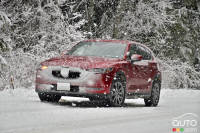Unlike full-size pickups, which are mostly exclusive to the North American market, midsize models as a species are much more widespread internationally. There are Rangers and Tacomas in South America, in some African countries, in Asia-Pacific and in the Middle East.
This market segment has gone through some tough times in North America, mainly because for a long time the prices for full-size pickups barely exceeded those of their smaller midsize cousins. GM successfully relaunched the mid-range truck lineup with the Colorado and Canyon, forcing Ford to react. Which brings us to 2019 and the return of the Ranger after an eight-year absence from the market. As for the Tacoma, it’s a survivor through and through; it’s resisted all the winds of changes and has been a constant presence on the market, even in the segment’s dark times.
Ford Ranger
Those of a certain age will remember the Ford Courier, a small truck that sold from 1972 to 1982 and was actually a joint venture between Mazda and Ford. The Ranger was the follow-up, appearing in 1988 and lasting until 2011.
But know this: the new-generation Ranger that returns for 2019 takes aim at a whole different clientele than its predecessor. For starters, Mazda is no longer in the picture, and the 2019 version of the Ranger is more imposing than the last generation that departed in 2011. This new Ranger is almost as big as the F-150 of the late 90s.
Specifications for the 2019 Ford Ranger
Our review of the 2019 Ford Ranger

A different approach
Unlike full-size models that have been conceived and designed specifically for North America, the Ranger, which originated in Australia and Asia-Pacific before coming over to our market, has different styling, with curves similar to those of models by Volkswagen, Mitsubishi and others. The bumpers are the main point of distinction for the North America version: ours are made of steel and mounted directly on the chassis for durability and superior shock resistance. Elsewhere in the world, the bumpers are plastic.
Canadian buyers are getting three models of the Ranger to choose from. The base version XL comes only with an extended cab. The XLT version comes in the extended cab or double cab (four doors) while the high-end Lariat is only available in double cab versions.
Add $1,400 to the price tag of any of those models to get the FX4 off-road kit. That package includes four part-time drive wheels, steel skid plates at the front and under the chassis, shock absorbers and off-road tires as well as magnetic grey trim.

Still true to EcoBoost
For the moment Ford is only offering a single 2.3L turbocharged 4-cylinder engine. It's essentially the same engine block that the Mustang has, though in the Ranger it produces 270 hp and 310 lb-ft of torque with the same 10-speed automatic transmission as the Mustang.
The Ranger comes as a RWD and as an option with 4WD. The latter configuration comes with a two-speed transfer case, an electronic locking rear differential and Ford's terrain management system that allows the driver to choose one of the following modes: Normal, Grass/Gravel/Snow and Mud/Sand.
You also get a new, low-speed, off-road cruise control (similar to the Toyota Tacoma’s crawl control) standard on all-wheel-drive models. Called Trail Control, it engages at speeds ranging from 1 to 30 km/h and can be slowed down to a new speed (instead of disengaged) by applying the brake.
Comfortable on the road and highly capable off it, the new Ranger is also able to tow 3,400 kg (7,500 lb). Occupants get to enjoy a quiet cabin with the latest Ford technology included. It’s still too early to talk about reliability. Prices range from $31,000 to $42,000 for a Lariat version.

Toyota Tacoma
Like other mid-range pickups, the Tacoma modestly started its career in a small compact format, back in 1995. Mainly sold in North and South America as well as in New Caledonia, it quickly established itself as a reliable and solid truck. The latest generation arrived in 2016 and was bigger, pushing the Tacoma into the midsize truck category. Last year the Tacoma received a few minor changes such as the inclusion of the Safety Sense P safety suit of systems that offers a pre-collision system with pedestrian detection, lane departure warning and automatic high beams.
Our review of the 2019 Toyota Tacoma TRD Pro
Specifications for the 2019 Toyota Tacoma

Simplified lineup
From the basic 4-cylinder, rear-wheel-drive model starting at around $ 32,000 to the off-road TRD and TRD Sport models, not to mention the new-for-2019 TRD Pro, the Tacoma’s lineup is simplified but still wide-ranging.
The basic model offers an access cab with two folding seats behind that are barely able to accommodate; more realistically that space is better for luggage. The Crew Cab models offer space for five adults and a 5-ft box (6 feet for the access cab). The Tacoma is a working person’s truck; you don’t buy it for the looks, but it is efficient.
The exception to this rule is the TRD Pro with its raised air intake and its sparkling blue colour, new for 2019. This one will attract attention, you can count on that. The TRD Pro (starting at $56,345) is tailor-made for inhospitable terrain. Equipped with a red logo protection plate, the TRD also includes a stainless steel exhaust system, Fox shock absorbers, front coil springs and reinforced rear leaf springs with off-road tires in addition to a host of luxury elements inside. This is the ultimate Tacoma model.

The basic model starts with a 2.7L engine developing 159 hp and 180 lb-ft of torque. Most models are equipped with a 6-speed automatic transmission, but the 4x4 versions of the TRD Sport and TRD Pro comes with a 6-speed manual gearbox.
The V6 trucks come with a 3.5L engine making 278 hp and 265 lb-ft of torque. The V6 has a towing capacity of 2,900 kg (6,400 lb), which is less than the Ford Ranger with the 4-cylinder. The 4-cylinder Toyota tows only 1,590 kg (3,500 lb).
Advantages of the Ford Ranger
The Ford Ranger is brand-new, so it’s more modern and its presentation is more technologically up-to-date, in addition to which it offers a more comfortable ride than the Tacoma at a better price and with better towing capacity and fuel economy.
The most-equipped Lariat version will set you back around $45,000 if you add the FX4 option. You’ll pay more than $56,000 for the equivalent TRD Pro from Toyota. Reliability remains an unknown factor because the Ranger is just entering the market.
Advantages of the Toyota Tacoma
Yes it’s true that the Tacoma is expensive - all those who know trucks will tell you that - but it’s also indestructible. You don’t have to worry about reliability and if you have the itch to off-road, outside of a Jeep Wrangler the Tacoma TRD Pro is probably the best thing to have to really have fun on impossible trails.

Similarities
Both trucks cater to those who don’t want the clutter of a full-size truck but need enough capacity to meet their needs. The format and number of configurations are also quite similar in both models.
Our verdict
Based on everyday use, the Ford Ranger is more comfortable, has better soundproofing and is more fuel-efficient; it probably makes more sense for a majority of customers. But for those who want a rugged workhorse and a truck that can handle anything, the Tacoma is the only choice. Plus, stay tuned because the Tacoma will offer a lot of new features in 2020.
Ford Ranger
We liked
Rigid chassis
Rolling comfort
Off-road skills
Towing capacity
We liked less
Fit and finish
Overall look is a bit dull
Only one engine choice
Toyota Tacoma
We liked
Recognized reliability
Off-Road Capability (TRD Pro)
Solid chassis
We liked less
Aging model
Fairly high fuel consumption
Useless 4-cylinder engine

Specifications
| 2019 Ford Ranger | 2019 Toyota Tacoma | ||
| ... | Transmission | 10-speed auto | 6-speed (manual +auto) |
| Drivetrain | 4WD | 4-cyl RWD | |
| Fuel consumption (city) | 11.8L/100 km | 12.1L/100 km | |
| Fuel consumption (highway) | 9.8L/100 km | 10.1L/100 km | |
| Drivetrain | V6 AWD (auto) | ||
| Fuel consumption (city) | 13.2.L/.100 km | ||
| Fuel consumption (highway) | 10.7.L/.100 km | ||
| Fuel tank | 68 litres | 80 litres | |
| Engine | |||
| Type | Gas | Gas | |
| Output | 270 hp | 159 hp | |
| Torque | 310 lb-ft | 180 lb-ft | |
| Cylinders | 4 | 4 | |
| Displacement | 2.3L turbo | 2.7L | |
| Output | 278 hp | ||
| Torque | 265 lb-ft | ||
| Cylinders | V6 | ||
| Displacement | 3.5L | ||
| Capacities | |||
| Bed | 5 & 6 feet | 5 & 6 feet | |
| Towing capacity | 3,400 kg | 1,590 kg (4-cylinder) | |
| Towing capacity | 2,600 kg (V6) | ||
| Dimensions | |||
| Length | 5,334 mm | 5,392 mm or 5,727 mm | |
| Width | 2,159 mm | 1889 mm or 1,910 mm | |
| Height | 1,803 mm | 1,793 mm | |
| Wheelbase | 3,200 mm | 3,235 mm or 3,571 mm | |
| Warranty | 3 yr/60,000 km | 3 yr/60,000 km | |
| Price | $30,969 to $42,289 | $31,000 to $56,345 |























